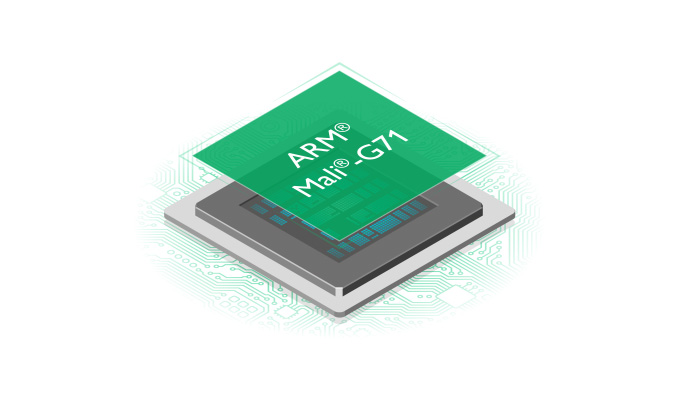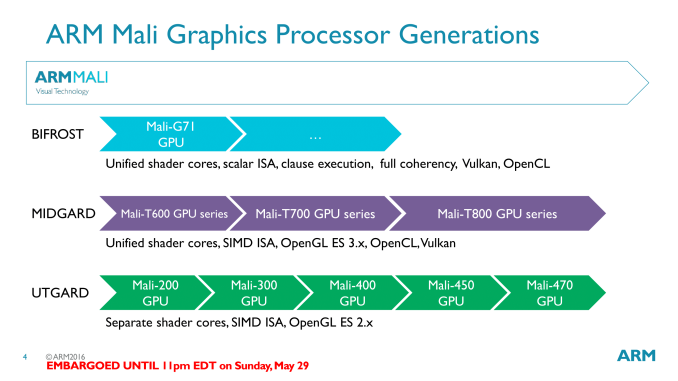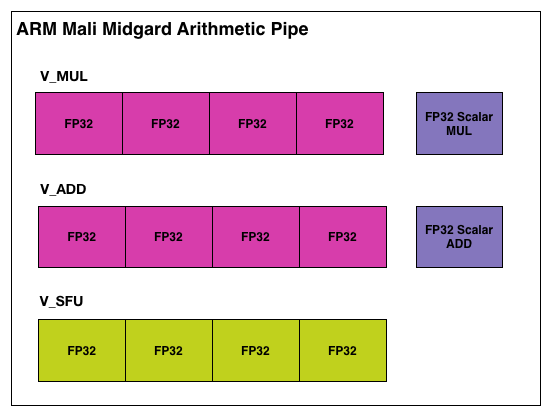ARM Unveils Next Generation Bifrost GPU Architecture & Mali-G71: The New High-End Mali
by Ryan Smith on May 30, 2016 7:00 AM EST
Over the last few years the SoC GPU space has taken an interesting path, and one I admittedly wasn’t expecting. At the start of this decade the playing field for SoC-class GPUs was rather diverse, with everyone from NVIDIA to Broadcom (and everything in between) participating in it. Consolidation in the GPU space would be inevitable – something we’ve already seen with SoC vendors dropping out – however I am surprised by just how quickly it has happened. In just six years, the number of GPU vendors with a major presence in high-end Android phones has been whittled down to only two: the vertically integrated Qualcomm, and the IP-licensing ARM.
That ARM has managed to secure most of the licensed GPU market for themselves is a testament to both their engineering and their IP licensing efforts. ARM’s path into this market has been non-traditional, having acquired an essentially unknown GPU vendor a decade ago, and growing it into the 800lb gorilla it has now become. ARM’s expertise in IP licensing, coupled with a somewhat unusual GPU architecture, has proven to be a powerful combination for the company as they have secured a number of significant wins from the high end to the low end.
Much of this growth was built on the back of the company’s GPU architecture of the last few years, Midgard. Initially launched in 2012, Midgard has been the cornerstone of ARM’s Mali 600, 700, and 800 series designs. As ARM’s first unified shader design for GPUs, Midgard has been extended over the years to support newer features such as geometry tessellation and 10bpc color, along with newer APIs such as OpenGL ES 3.1/3.2 and Vulkan.
However as Midgard approaches its fourth birthday and the SoC GPU landscape evolves, Midgard’s time at the top will soon be coming to an end. Amidst the backdrop of Computex 2016 and alongside their new Cortex-A73 CPU, ARM is announcing their next generation GPU architecture, Bifrost. A significant update to ARM’s GPU architecture, Bifrost will first be deployed in ARM’s Mali-G71 GPU.
Recap: Mali & VLIW
One of the interesting aspects of SoC GPU development over the years is that it has been a very distinct echo of larger discrete GPU development. Many innovations and changes that first show up with dGPUs will show up in SoC GPUs a few years later, as newer manufacturing processes allow for those developments to fit within the extreme space and power requirements of an SoC-class GPU. At the same time mobile games/graphics development follows a similar path, with mobile application developers picking up rendering techniques first used elsewhere.
ARM’s architectural development, in turn, has been a good example of this process. The non-unified Utgard architecture gave way to the unified Midgard architecture in 2012, about 6 years after dGPUs first made the transition. And as we learned when we examined the Midgard architecture in depth, Midgard was an architecture well suited for the rendering paradigms of the time.
Midgard’s shader core, in short, was an Instruction Level Parallelism-centric design, employing a Very Long Instruction Word (VLIW) instruction format. To achieve maximum utilization out of Midgard’s shader cores, you needed to be able to extract a significant amount of ILP – 4 concurrent instructions – in order to fill all of the slots in a shader core. This sort of design maps well to basic graphics workloads, as 4 color component RGBA is a natural fit for the 4 lanes of ARM’s VLIW-4 design. Furthermore VLIW designs are traditionally very space efficient, as there’s relatively little overhead logic, which is always a boon for the tight constraints of the SoC space.
However getting back to what we said earlier about SoC GPUs being an echo of discrete GPUs, as we’ve seen there, VLIW does have a limited shelf life. Newer rendering paradigms often work with just 1 or 2 components at once, which leaves open lanes that need to be filled to achieve full GPU utilization. A good shader compiler can help here, but it does become an escalating technology war over time, as getting good performance becomes increasingly compiler-centric, and writing a compiler that can extract the necessary ILP is a challenge in and of itself. What history has shown us – and what is going to happen again in the mobile market – is that rendering workloads will continue to shift away from a style that is suitable for VLIW.












57 Comments
View All Comments
Ranger1065 - Monday, May 30, 2016 - link
Interesting but not quite the GPU review the faithfull are awaiting...hope springs eternal.Shadow7037932 - Monday, May 30, 2016 - link
This is more interesting than a GTX 1070/1080 review imo. We more or less know what the nVidia cards are capable of. This ARM GPU design will be relevant for the next 2-3 years.Alexey291 - Monday, May 30, 2016 - link
Well yeah, ofc it's not interesting anymore because by the time their reviews hit whatever it is they are reviewing is a known quantity. 1080 in this case is a perfect example.name99 - Tuesday, May 31, 2016 - link
Oh give it a rest! Your whining about the 1080 is growing tiresome.SpartanJet - Monday, May 30, 2016 - link
Relevant for what? Phone GPU's are fine as is. For mobile gaming? Its all cash shop garbage. For productivity? ADroid and iOS pale in comparison to a real OS like Windows 10.I find the Nvidia much more interesting.
name99 - Tuesday, May 31, 2016 - link
"Phone GPUs are fine as is."And there, ladies and gentlemen, is the "640K is enough for anyone" of our times...
Truly strong the vision is, in this one.
imaheadcase - Tuesday, May 31, 2016 - link
He is not wrong though. A faster GPU on one offers nothing for people as of right now. If you look at the mobile apps that are used, not a single one would even come close to using what they use now..and phones are at max quality for the screen size they use.The only way phones can improve now that users would notice is storage/CPU/and better app quality in general which is terrible.
shadarlo - Tuesday, May 31, 2016 - link
You realize that GPU's are used for things beyond prettying up a screen right?Lets just stop advancing mobile GPU's because in the future we will never use anything more advanced that needs more power or less power usage... *eye roll*
ribzy - Monday, November 21, 2016 - link
I think what he's trying to say is that the content is not available or sufficient right now to really justify the cost. Let's say you built a car but don't have the fuel that's needed to power it. Or what about those that got a 4K TV early and now are stuck with something that doesn't have HDR and that runs old, not updateable TV software. I understand his concern.mr_tawan - Thursday, June 2, 2016 - link
Well as the phone's and tablet's resolution is going ridiculously higher and higher everyday, having strong GPU is a must. It's not all about gaming, it affects day-to-day use as well. Everything on displays now on every OS nowadays are hardware-accelerated. And the current mobile GPU are under-power comparing to the task it's given (eg. driving 2K displays at 60fps).